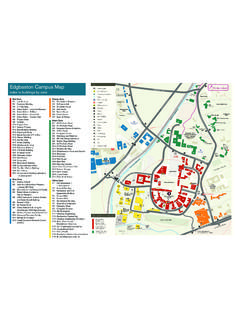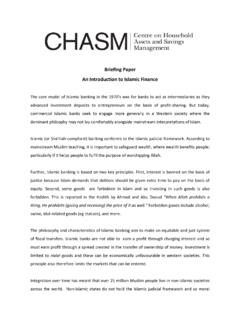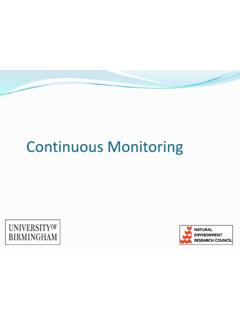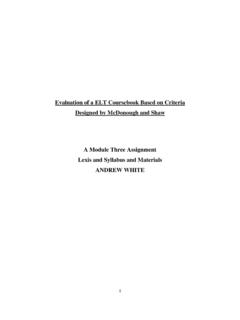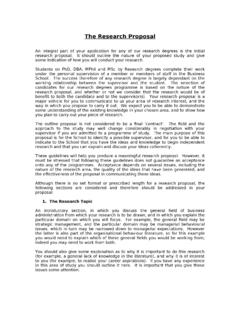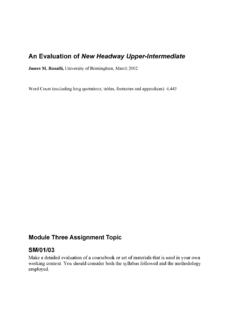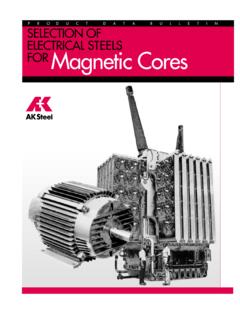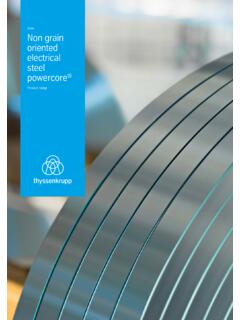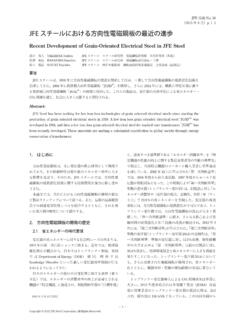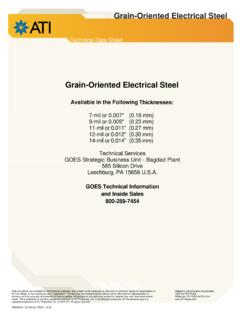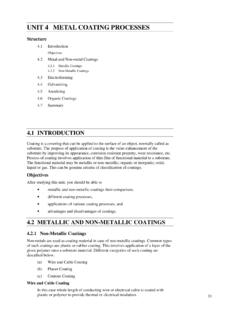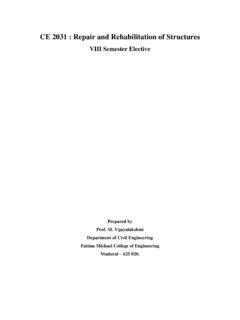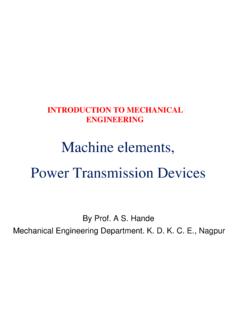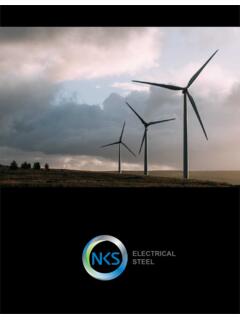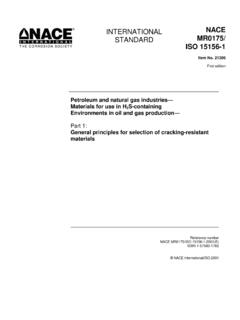Transcription of Magnetic Materials: Soft Magnets - University of Birmingham
1 Magnetic Materials: soft Magnets soft Magnetic materials are those materials that are easily magnetised and demagnetised. They typically have intrinsic coercivity less than 1000 Am-1. They are used primarily to enhance and/or channel the flux produced by an electric current. The main parameter, often used as a figure of merit for soft Magnetic materials, is the relative permeability ( r, where r = B/ oH), which is a measure of how readily the material responds to the applied Magnetic field. The other main parameters of interest are the coercivity, the saturation magnetisation and the electrical conductivity.
2 The types of applications for soft Magnetic materials fall into two main categories: AC and DC. In DC applications the material is magnetised in order to perform an operation and then demagnetised at the conclusion of the operation, an electromagnet on a crane at a scrap yard will be switched on to attract the scrap steel and then switched off to drop the steel . In AC applications the material will be continuously cycled from being magnetised in one direction to the other, throughout the period of operation, a power supply transformer. A high permeability will be desirable for each type of application but the significance of the other properties varies.
3 For DC applications the main consideration for material selection is most likely to be the permeability. This would be the case, for example, in shielding applications where the flux must be channelled through the material . Where the material is used to generate a Magnetic field or to create a force then the saturation magnetisation may also be significant. For AC applications the important consideration is how much energy is lost in the system as the material is cycled around its hysteresis loop. The energy loss can originate from three different sources: 1.
4 Hysteresis loss, which is related to the area contained within the hysteresis loop; 2. eddy current loss, which is related to the generation of electric currents in the Magnetic material and the associated resistive losses; 3. anomalous loss, which is related to the movement of domain walls within the material . Hysteresis losses can be reduced by the reduction of the intrinsic coercivity, with a consequent reduction in the area contained within the hysteresis loop. Eddy current losses can be reduced by decreasing the electrical conductivity of the material and by laminating the material , which has an influence on overall conductivity and is important because of skin effects at higher frequency.
5 Finally, the anomalous losses can be reduced by having a completely homogeneous material , within which there will be no hindrance to the motion of domain walls. Iron-Silicon Alloys These alloys are used for transformer cores and are known as electrical steels. In the power industry electrical voltage is almost always AC and at low frequency, 50-60Hz. At these frequencies eddy currents are generated in the transformer core. Alloying the Fe with Si has a large marked effect on the electric resistivity of the material , with an increase of a factor of 4 for 3wt%Si.
6 Silicon also has the benefit of reducing the magnetostriction ( length change on magnetisation) and the magnetocrystalline anisotropy. In addition, the material is used in the form of laminations, typically to thick. The addition of too much silicon makes the material extremely brittle and difficult to produce, giving a practical limitation of 4wt% to the amount of Si that can be added. Recently, a technique has been developed to produce laminations with >6wt% Si, by a SiCl4 chemical vapour deposition treatment to enrich the laminations with Si after forming the laminations.
7 Typically most electrical steels will contain between 3 and 4 wt% Si. For transformer applications the flux lies predominantly in the length of the laminations and therefore it is desirable to enhance the permeability in this direction. This is achieved by various hot and cold rolling stages to produce textured sheets, known as grain- oriented silicon- steel , with the [001] direction in the length of the lamination. The <001> type crystal directions are the easy directions of magnetisation and hence the permeability is greater. Figure 11, shows the anisotropy of Fe and illustrates the two types of texture that can be achieved, which are known as cube-on-edge and cube texture.
8 Note that the cube texture has two <001> type directions in the plane of the sheet and provides an advantage if E-shaped laminations are to be cut from the sheet. Figure 11: The anisotropy of Fe and types of texture that can be achieved. Amorphous Nano-Crystalline Alloys These materials can be produced in the form of a tape by melt-spinning. The alloys consist of iron, nickel and/or cobalt with one or more of the following elements: boron, carbon, phosphorous and silicon. They have extremely low coercivity, an order of magnitude less than standard Fe-Si, and consequently lower hysteresis losses.
9 However, they have relatively low magnetisation and are not suitable for high current applications. They do find a market in low current applications and specialised small devices where they can compete with Ni-Fe. Instead of casting the alloy onto a rotating wheel to produce tapes it is also possible to squirt a stream of molten alloy into a bath of water or oil to produce amorphous wires of typically 50 m thick. These wires show a very square hysteresis loop with large changes in magnetisation at low field, making them ideal for sensing and switching.
10 Recently there has been much interest in nano-crystalline material , which is produced by annealing the amorphous material . These alloys can be single phase but are usually comprised of nano-sized grains, in the range 10-50nm, in an amorphous matrix. They have relatively high resistivity, low anisotropy and good mechanical strength. Nickel-iron alloys These alloys, known as permalloy, are extremely versatile and are used over a wide range of compositions, from 30 to 80wt%Ni. Over this composition range the properties vary and the optimum composition must be selected for a particular application.
